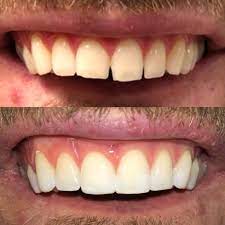If you’ve ever looked in the mirror and wished you could instantly improve the shape, color, or alignment of your teeth without extensive procedures, composite bonding might be exactly what you need. This popular cosmetic dental treatment uses a tooth-colored resin to restore and enhance teeth, often in just one appointment. From repairing chips to closing small gaps, composite bonding offers a quick, minimally invasive way to achieve a natural-looking smile. In this guide, we’ll break down what it is, how it works, its benefits, risks, and how to decide if it’s the right choice for your smile.
What Is the Treatment and How It Works?
Composite Bonding In Dubai involves applying a soft, moldable resin directly to the surface of your tooth. This resin is carefully shaped to correct imperfections such as chips, cracks, uneven edges, or discoloration. Once sculpted, the material is hardened with a special curing light and polished to blend seamlessly with your natural teeth. Unlike other treatments that require removing significant amounts of enamel, bonding is conservative and usually requires no anesthesia. The result is a tooth that looks completely natural while maintaining its original structure.
Importance of Composite Bonding:
For many people, cosmetic composite bonding is more than just an aesthetic fix—it’s a confidence booster. It can address a range of common smile concerns:
- Chipped or broken teeth
- Small gaps between teeth
- Mild tooth misalignment
- Stains or discoloration unresponsive to whitening
- Uneven or worn edges
By restoring symmetry and brightness, bonding not only improves your smile but can also enhance how you feel about your overall appearance. The procedure’s minimally invasive nature means you can enjoy the benefits without major alterations to your teeth.
Types of Composite Bonding:
There are different variations of dental bonding treatment, each tailored to specific needs:
- Direct composite bonding – The most common type, where resin is applied and shaped directly on the tooth in one visit.
- Adhesive bonding – Used for attaching restorations such as crowns, veneers, or bridges.
- Composite edge bonding – Focuses on reshaping and lengthening the edges of teeth for a more uniform appearance.
The choice depends on the issues you want to address and your smile goals.
Preparation for Composite Bonding:
One of the biggest advantages of composite resin bonding is how little preparation it requires. The process usually involves:
- Choosing a resin shade that closely matches your natural teeth.
- Gently roughening the tooth surface for better adhesion.
- Applying a conditioning liquid.
- Sculpting the resin into the desired shape.
- Hardening the material with a curing light.
- Polishing for a smooth, glossy finish.
This streamlined approach makes bonding one of the quickest cosmetic dental treatments available, while also preserving most of your original tooth structure.
Aftercare for Composite Bonding:
Looking after your teeth post-treatment is crucial for keeping your tooth bonding results in top condition:
- Brush twice daily with a fluoride toothpaste.
- Avoid biting hard objects like ice or pens.
- Reduce consumption of staining drinks such as coffee and red wine.
- Wear a nightguard if you grind your teeth.
- Schedule regular dental checkups to monitor the bonding’s condition.
With good care, composite bonding can last for several years before needing touch-ups.
Ideal Candidate for Composite Bonding:
Composite tooth bonding is ideal for people seeking quick cosmetic improvements without undergoing complex dental procedures. You may be a great candidate if you have:
- Minor chips or cracks
- Slightly uneven or misshapen teeth
- Mild discoloration
- Small gaps between teeth
- Good oral hygiene and no significant decay or gum disease
If your concerns are more severe—such as large cavities, significant misalignments, or major structural damage—other treatments may be more suitable.
How to Choose the Right Clinic?
Selecting the right provider for cosmetic bonding treatment can make a big difference in your results. Look for a professional who offers a thorough consultation, explains your options, and uses high-quality bonding materials. Reviewing before-and-after photos from previous patients can also give you a clear idea of the provider’s skill in creating natural, seamless results.
Risks of Composite Bonding:
While Composite Bonding is generally safe and effective, it’s important to be aware of potential downsides:
- The resin material can chip or break if you bite on hard objects.
- Bonding may stain over time, especially with frequent coffee or tea drinking.
- It may require touch-ups every few years.
- It is not as strong or long-lasting as crowns or veneers.
Knowing these risks will help you maintain realistic expectations.
Benefits of Composite Bonding:
The popularity of tooth-colored composite bonding is no accident—it offers several key benefits:
- Quick and painless procedure
- Natural-looking results that blend with your teeth
- Minimally invasive with little to no enamel removal
- Reversible and repairable if needed
- Often completed in just one visit
This makes it an attractive option for those wanting immediate improvements.
FAQs About Composite Bonding:
Does composite bonding hurt?
No, most people find it completely painless.
How long does composite bonding last?
With good care, it can last 3–10 years before needing touch-ups.
Can you whiten composite bonding?
No, whitening products do not work on resin, so stains must be polished or replaced.
Can composite bonding fix crooked teeth?
It can improve the look of slightly misaligned teeth, but not replace orthodontics.
What foods should I avoid?
Limit hard, sticky, or highly pigmented foods and drinks to prevent damage and staining.
Conclusion:
If you’re searching for a fast, effective way to transform your smile without invasive procedures, composite bonding could be the perfect choice. By using tooth-colored resin, it can repair chips, close gaps, correct minor misalignments, and improve tooth color—all while preserving your natural teeth. With proper care, composite bonding offers a beautiful, long-lasting enhancement to your smile that blends seamlessly with your existing teeth.





Comments